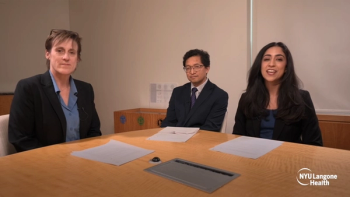
Dispersive ophthalmic viscosurgical device found to be safe, effective in clinical trials
Mark Packer, MD, speaks on his 2022 AAO poster: "Safety and Effectiveness of a New FDA-Approved Dispersive Ophthalmic Viscosurgical Device."
Video transcript
David Hutton: I'm David Hutton of Ophthalmology Times. The American Academy of Ophthalmology is hosting its annual conference in Chicago, and we're providing all the coverage you've come to expect. Today I'm joined by Dr. Mark Packer of Packer Research Associates to discuss his poster titled "Safety and effectiveness of a new FDA approved dispersive ophthalmic viscosurgical device."
Dr. Packer, thanks so much for joining us today. Tell us about your presentation.
Mark Packer, MD: Thank you, David. Well, I've worked with Bausch and Lomb over the last really almost a decade to develop a new viscoelastic. And we finally have brought this to market it's called ClearVisc. That's the brand name and it was just approved by FDA, and it's a dispersive viscoelastic. So it's special purpose is protection of the corneal endothelial particularly, but also other interocular structures during the process of phacoemulsification.
So, as you may know, the way that FDA approves these things is by doing a masked, prospective randomized study in which patients are operated for routine cataract surgery either with a new investigational device or with a comparator control device. And in this case, we chose the market leader dispersive viscoelastic, VISCOAT, manufactured by Alcon, as the control. And so patients were randomized to surgery either with ClearVisc or with VISCOAT.
The unique property of ClearVisc is really that it includes sorbitol. So sorbitol is essentially an antioxidant, and the concept here is to quench free radicals that are produced during the phacoemulsification process as the ultrasonic tip is vibrating in the eye. There's a lot of chemical changes going on including the production of free radicals, which can then convert to these highly reactive oxygen species which damage the corneal epithelium. So the inclusion of sorbitol is kind of the unique thing about ClearVisc.
And so anyway, we did this head-to-head, randomized, masked control trial. Basically, there are two important end points. The first is in terms of effectiveness, we're looking at protection of the corneal endothelium. And so what we look at there is corneal endothelial cell density, both preoperatively and again postoperatively at approximately three months, which is about the time when the initial sort of damage has settled down. And we've reached kind of a steady state, if you look at studies of the corneal endothelium after cataract surgery, you see there's a fall off right away typically around 10% in most studies, and then it kind of slows back down to a physiologic rate of about 1% to 2% a year thereafter. So we looked at endothelial cell density, for effectiveness, how well we protect the endothelium.
And then for safety, we look at increased intraocular pressure, because as every surgeon knows, if you leave residual viscoelastic in the eye, you tend to get a pressure spike that is quantified by FDA by setting a threshold of 30 millimeters of mercury. So pressures below 30, we kind of ignore; if the pressure hits 30, that's when we register an adverse event. And then surgeons are allowed to treat either with topical medication or aqueous tap, whatever they think necessary. But below 30, they don't treat. And that's so that we don't mask any potential pressure spikes.
So we enrolled 184 eyes, so 184 patients and the ClearVisc arm, and 188 eyes of 188 patients in the VISCOAT arm for a total of 372. And they were quite well balanced, you know, because it's randomized, so you would expect this, but quite well balanced in terms of all of the important characteristics like nuclear density, which of course is a big factor in endothelial cell density loss, right?
So for FDA, the point is non-inferiority. Basically, we're not looking to prove that we're better than the control, we're just looking to prove that we're as good as the current market leader. And that's exactly what we did.
So basically, if you look at the graphs that are presented in my presentation, you'll see that the incidence of elevated pressure is almost identical between the two groups. If you look at baseline post-surgery, around 6 hours, we measured it 4 to 6 hours, which is right when the peak pressure occurs, and then again, 24 hours later.
Pre-op, the mean was about 15. At that 4 to 6 hour visit, the main pressure was 25, and then the next day the mean pressure was back to around 20.
So really very, very similar between the two groups, and also very, very similar in terms of endothelial cell loss. We saw about 8.4% in the ClearVisc group 6.8% in the VISCOAT group, and those were not statistically different.
So essentially, we showed that this new dispersive works just as well as VISCOAT for both protection of the endothelium and prevention of IOP spikes postoperatively.
Adverse events were pretty balanced between the two groups. There was nothing unexpected that occurred, you know, no unusual rates of cystoid macular edema or iritis, which are things that I know people look at because we are using a new viscoelastic, you want to make sure it doesn't engender any type of inflammatory reaction, and we certainly did not see anything like that.
In conclusion, you know, ClearVisc met its primary safety and effectiveness end points, non-inferior to VISCOAT. We now have a new option in cataract surgery, which is really exciting. It's been quite a while. I think the most recent one was EndoCoat, which was now quite a number of years ago. And so now we have a new option in dispersive viscoelastics for surgeons in the US. Thanks so much.
Hutton: Thank you.
Newsletter
Don’t miss out—get Ophthalmology Times updates on the latest clinical advancements and expert interviews, straight to your inbox.













































